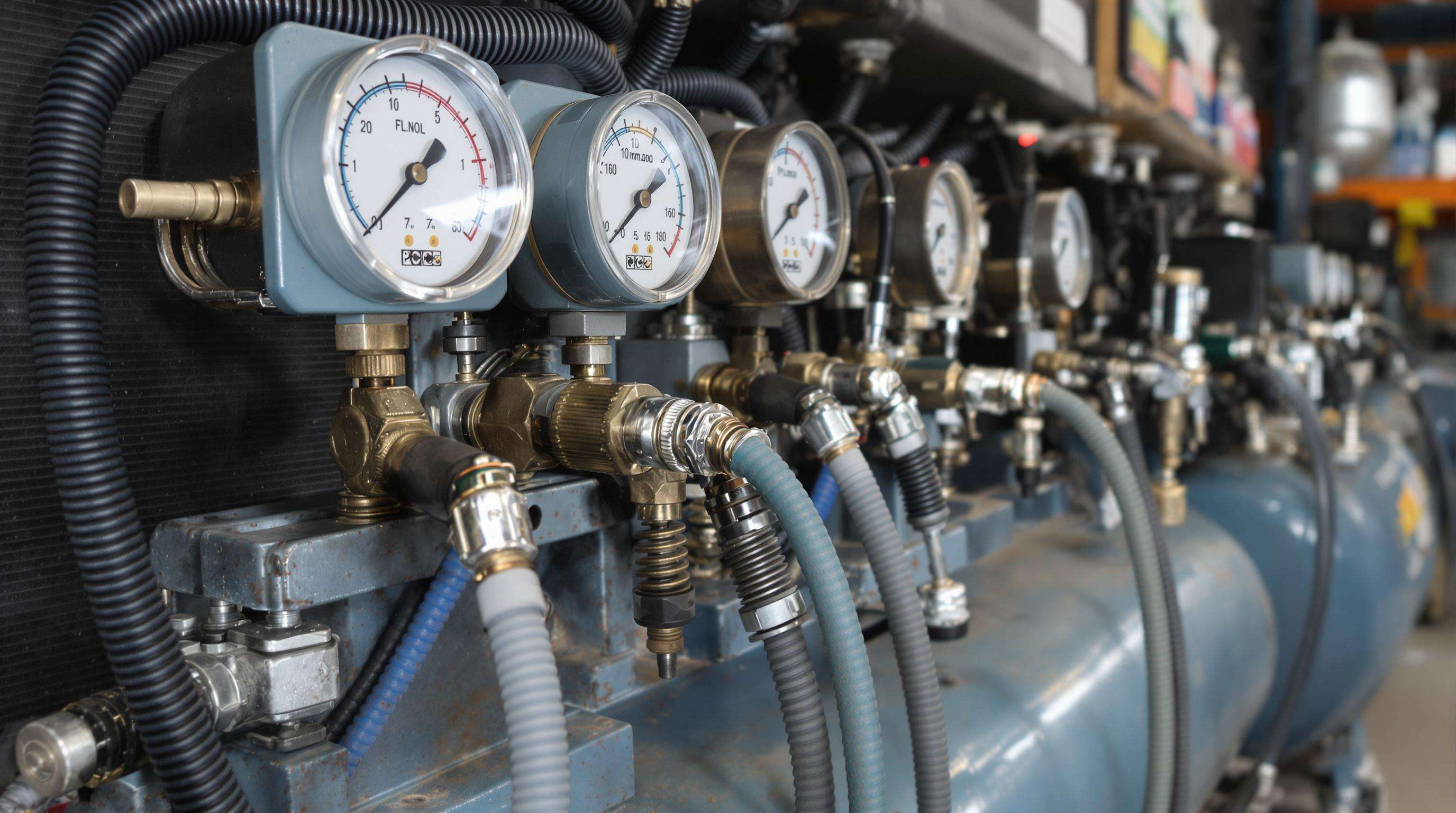Understanding CFM Requirements for Air Compressor Machines

Defining Air Flow Rate (CFM) and Its Operational Impact
Cubic Feet per Minute (CFM) is the amount of air volume the air compressor can produce per minute. This airflow level is what determines the number of tools that run at the same time and how efficient it is. When CFM doesn't measure up, tools flood or work poorly — for example, a paint sprayer needs 4-9 CFM to spray evenly. Tools that are engineered for continuous use require 20-30% more CFM to prevent overheating. Sufficient CFM rating maintains torque in impact wrench and prevents pressure drop under load sandblasting.
CFM Ranges for Light-Duty vs Heavy-Duty Applications
For light-duty uses, such as inflating tires, a compressor that can produce 3-4 CFM should meet your needs. Medium-duty operations — such as auto body shops with impact wrenches — need 4-9 CFM. Lots of industrial processes like sandblasting require more than 10 CFM. Foundries have rotary screw compressors that discharge over 100 CFM with metal cutting pneumatic tools that are running all the time. Correct CFM for application means no wasted energy, with “over-sized” compressors resulting in “unloaded cycling” – an $840 waste of power annually (Pneumatic Efficiency Council 2023).
Calculating CFM Needs for Multi-Tool Operations
Calculate multi-tool CFM using these steps:
- List concurrent tools and individual CFM requirements.
- Sum CFM values while adding 25% for leaks and pressure drops.
For instance, running an impact wrench (5 CFM) with a die grinder (8 CFM) requires (5+8)×1.25=16.25 CFM minimum. Advanced facilities install pressure flow sensors to monitor real-time CFM consumption and adjust compressor staging. Strategic air receiver tank installation can reduce peak load demands by 15-20% for intermittent operations.
PSI Specifications in Air Compressor Machine Selection
The Role of Pressure (PSI) in Tool Activation Efficiency
Air powered tools have precise PSI requirements to function, and most of the industrial machines maintain 90-100 PSI for great performance. Insufficient pressure results in underperforming tool cycles or lack of engagement - too much PSI stresses compressors and speeds up seal wear. For instance, pneumatic rachets will not stall at 75 PSI where X-Y exceeds tool's limit by 20%, consumes 12% more energy than needed. Matching PSI to tool needs eliminates air leaks, which account for 25-30% of wasted energy in a compressed air system,according to compressed air efficiency studies.
High-Pressure vs Low-Pressure Industrial Applications
- Low-Pressure (10-40 PSI): Used for inflation tasks and delicate surface treatments
- Medium-Pressure (50-110 PSI): Powers 90% of workshop tools like nail guns and sanders
- High-Pressure (120-175 PSI): Reserved for industrial sandblasting and hydraulic system testing
Over-pressurizing tools by 15% increases component wear rates by 40% while providing no performance benefit. Dual-circuit compressor systems allow simultaneous operation of low-PSI painting tools and high-PSI grinders without pressure conflicts.
PSI Maintenance Strategies for Optimal Performance
Regular maintenance prevents PSI fluctuations that reduce tool efficiency:
- Test pressure switches weekly using calibrated gauges
- Replace air filters quarterly to maintain airflow integrity
- Conduct annual valve seat inspections on reciprocating compressors
- Install pressure regulators downstream for multi-tool environments
Facilities implementing real-time PSI monitoring systems report 32% fewer pressure-related breakdowns compared to manual checking methods. Digital displays with ±1 PSI accuracy help operators maintain optimal pressure during extended production runs.
Power Source Dynamics in Air Compressor Machines
HP/KW Ratings and Their Impact on Energy Consumption
The rating of HP (horsepower) and KW (kilowatt) determines the work limit of air compressor systems, with higher ratings that allowing the greater airflow rates. A 10 HP industrial compressor will use up to 40% more power than a 7.5 HP model and flow 20-25% more CFM (Compressed Air & Gas Institute 2023). Sizing is key to prevent wasting energy — oversized compressors short cycle, and undersized compressors work too hard. The fuel is used by the electric motor ( Newell, 1997 ) and, hence, the prediction of motor efficiency will be crucial to its fuel management. Energy costs account for about 70% of the total ownership costs over 10 yrs.
Electric vs Gas-Powered Compressor Tradeoffs
| Power Source | Optimal Use Case | Noise Level | Duty Cycle Limit | Mobility |
|---|---|---|---|---|
| Electric (3-15HP) | Indoor workshops, fixed installations | 65-75 dB | 60-70% continuous run | Limited by power cords |
| Gas (5-25HP) | Construction sites, remote operations | 80-90 dB | 75-90% continuous run | High with fuel autonomy |
Electric models incur 30-50% lower hourly operating costs but require stable three-phase power, while gas units excel in remote applications despite higher emissions. Maintenance costs diverge significantly—gas compressors need regular oil changes and spark plug replacements, adding $0.15-$0.25 per operating hour (Fluid Power Association 2022).
Duty Cycle Limitations Across Power Configurations
Duty cycle ratings define how long a unit will sustain its intended RTI or Recommended Total Time in operation (ie: 30-60min for a mechanic vs. 100-120min for an electric model); an electric vs. mechanic can be used for up to 60-70% of a given hour, where as a gas hydraulic may run 85-95% of the time. Above 75% duty cycles, thermal management becomes an issue̴‾oversized cooling fans can decrease downtime by 40% in heavy-use conditions (International Compressor Standards Committee 2023). Portable devices with battery hybrids are now able to work at 50% duty cycle without any loss of performance between mobile and stationery sector.
Industrial Air Compressor Types Compared

Reciprocating Compressors: Cost vs Maintenance Realities
Reciprocating compressors are significantly cheaper than other types of industrial air compressors, with them being 40-60% cheaper to purchase than rotary screw models. Their piston drive mechani- calensa eis th mot h ntel aition r almost any intermittent application where air is needed, such as auto body repair and a wide variety of small manufacturing operations needi ≤50 CFM. Yet their 300-500 hour maintenance intervals for valve replacements and lubrication provide 30-50% increased annual maintenance expenses over a rotary approach. The loss of efficiency in these compressors during continuous duty results in vibration levels greater than 85 dB(A) in two-stage units – an important consideration for those concerned with worker comfort.
Rotary Screw Compressors in Continuous Operation
RSC’s maintain 90-95% volumetric efficiency while operating at 24/7 levels, so they are perfect for food processing and other plants that need ≥100 CFM. Twin-screw stages keep vibration down to ≤70 dB(A) and outputting 100-125 PSI unflaggintorzy intensity. Upfront, the 8-10× more expensive (vs. reciprocating) machines run 2-3× more to boot—due to higher service needs of one every 8,000-10,000 hours for 15-25% more power efficiency at 30-100 HP. Oil-flooded are prevalent in metal working, oil-free in ISO 8573-1 Class 0 for pharmaceuticals.
Centrifugal Compressors for High-Capacity Demands
Centrifugal Fans for the Toughest Industrial Demands Provide upto 2,000-100,000 CFM for petro-chemical, power generation, and other industrial facilities. With two to three impeller stages, we can realize 15:1 pressure ratios at 70-85% isentropic efficiency – 40-60% better than reciprocating units for large installations. Although, initial costs of more than $500k install for 10,000 CFM units, their 10 year life and speed controllable inlet guide vanes help to guide the savings on energy overnight. Dynamic instability requires special training risks above 70% turndown, making the maintenance cost effective only for plants that require ≥60% annual utilization.
Upfront Pricing vs Long-Term Operational Expenses
The initial purchase price of an air compressor typically represents only 20% of its total lifetime costs. Operational expenses—primarily energy consumption (averaging 70-80% of ownership costs) and maintenance—dominate long-term expenditures. Facilities prioritizing upfront savings risk higher cumulative expenses from inefficient models.
Energy Efficiency's Impact on Total Ownership Cost
Energy consumption directly determines operational costs, with inefficient compressors increasing TCO by 30-50% over a decade. Selecting optimized models with variable-speed drives (VSDs) reduces idle power waste, typically cutting energy use by 25-35%. These savings often offset higher initial investments within 2-5 years while extending equipment lifespans.
Industry Paradox: Higher CFM Doesn't Always Mean Better Value
Overestimating CFM (cubic feet per minute) requirements leads to inflated ownership costs. Oversized compressors consume excess energy during partial-load operation and require more frequent maintenance. A precisely calculated CFM matching actual demand improves efficiency by 15-25%, proving tailored capacity often yields superior ROI versus maximum-output models.
FAQ
What is CFM in air compressors and why is it important?
CFM, or Cubic Feet per Minute, measures the air volume an air compressor can produce per minute. It's crucial for determining how many tools can run simultaneously and how efficiently they perform.
How do I calculate CFM needs for multiple tools?
List all tools and their individual CFM requirements, sum them, and add 25% for leaks and pressure drops. This total will give you the minimum CFM your compressor needs to provide.
What is the difference between PSI and CFM?
PSI measures pressure, indicating how much force the air exerts, while CFM measures volume, indicating how much air is delivered. Both are crucial specifications for ensuring proper tool operation.
What factors influence the energy consumption of air compressors?
Energy consumption is influenced by the compressor's horsepower (HP), usage patterns, and efficiency levels. Oversized compressors can lead to wasteful energy consumption during partial-load operations.
Table of Contents
- Understanding CFM Requirements for Air Compressor Machines
- PSI Specifications in Air Compressor Machine Selection
- Power Source Dynamics in Air Compressor Machines
-
Industrial Air Compressor Types Compared
- Reciprocating Compressors: Cost vs Maintenance Realities
- Rotary Screw Compressors in Continuous Operation
- Centrifugal Compressors for High-Capacity Demands
- Upfront Pricing vs Long-Term Operational Expenses
- Energy Efficiency's Impact on Total Ownership Cost
- Industry Paradox: Higher CFM Doesn't Always Mean Better Value
- FAQ

